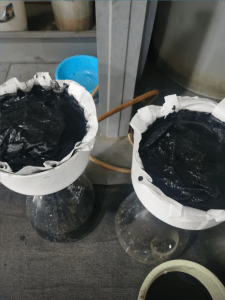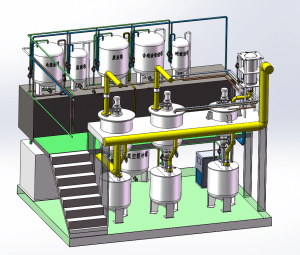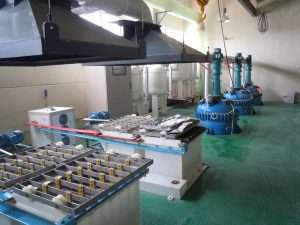Call us now:
The purification of gold by electrolysis is a common method used to refine gold that contains impurities. The process involves the use of an electrolytic cell and the passage of an electric current through a gold-containing solution, known as the electrolyte. Here's a step-by-step explanation of the process:
Preparation: The first step is to prepare the electrolyte solution. This typically involves dissolving impure gold in a mixture of hydrochloric acid (HCl) and nitric acid (HNO3), known as aqua regia. Aqua regia is a strong acid mixture that can dissolve most impurities in gold.
Electrolytic cell setup: The electrolytic cell consists of two electrodes—an anode and a cathode. The anode is typically made of impure gold, while the cathode is made of pure gold. Both electrodes are placed in the electrolyte solution.
Electrolysis process: When an electric current is passed through the cell, metal ions from the impure gold anode are oxidized and dissolved into the electrolyte. These metal ions migrate through the electrolyte towards the cathode. At the same time, at the cathode, gold ions in the electrolyte are reduced and deposited onto the cathode surface, resulting in the purification of gold.
Electrolyte replenishment: As the electrolysis process continues, the impurities in the gold anode will accumulate in the electrolyte. To maintain the effectiveness of the electrolysis, it is necessary to periodically replace or replenish the electrolyte with fresh aqua regia solution.
Collection and further processing: Once a sufficient amount of gold has been deposited on the cathode, the process is stopped. The gold deposited on the cathode is carefully removed, rinsed, and dried. This material is often referred to as "electrolytic gold" or "electrorefined gold." The collected gold can then undergo additional refining processes, such as smelting, to obtain the desired purity.
It's important to note that electrolysis is just one step in the overall gold refining process. Prior to electrolysis, the gold ore or gold-containing material undergoes several other processes, such as crushing, grinding, and chemical treatments, to extract gold from the ore. The electrolytic refining step serves to further purify the gold obtained from these initial processes.
Electrolysis is a widely used technique for gold purification because it is relatively efficient and can yield high purity levels. However, it requires proper safety precautions due to the use of strong acids and the presence of toxic fumes. It is recommended to carry out this process in a well-ventilated area and to follow established safety guidelines.
Certainly! Here's some additional information about the purification of gold by electrolysis:
Current and voltage considerations: The current and voltage applied during the electrolysis process can vary depending on the specific setup and the desired results. Generally, a low current and voltage are used to prevent the formation of unwanted side reactions and to ensure a controlled deposition of gold onto the cathode. The electrolysis process can take several hours or even days to complete, depending on the quantity of gold being refined.
Monitoring and control: It is crucial to monitor the electrolysis process carefully. The progress of the refining can be monitored by measuring the voltage, current, and the weight of the cathode. Regular monitoring helps maintain control over the process and ensures the desired level of purity is achieved.
Refining efficiency and limitations: While electrolysis is an effective method for purifying gold, it is not capable of removing certain impurities such as platinum group metals or some high melting point impurities. For the removal of these impurities, additional refining techniques like chemical treatments or fire assay may be required.
Safety precautions: Electrolysis of gold involves working with strong acids and potentially hazardous chemicals. It is essential to follow proper safety precautions when handling and working with aqua regia and other related materials. Safety measures may include wearing protective clothing, gloves, and goggles, and working in a well-ventilated area or under a fume hood.
Environmental considerations: The electrolytic refining process generates waste products, including spent electrolyte and sludge containing residual impurities. These waste materials must be handled and disposed of properly to prevent environmental contamination. It is important to adhere to local regulations and guidelines for the disposal of hazardous materials.
Overall, electrolysis is a commonly employed method for purifying gold due to its efficiency and ability to achieve high purity levels. However, it is worth noting that there are other refining techniques available, such as chemical solvent extraction or smelting, which may be preferred in certain situations depending on the nature of


